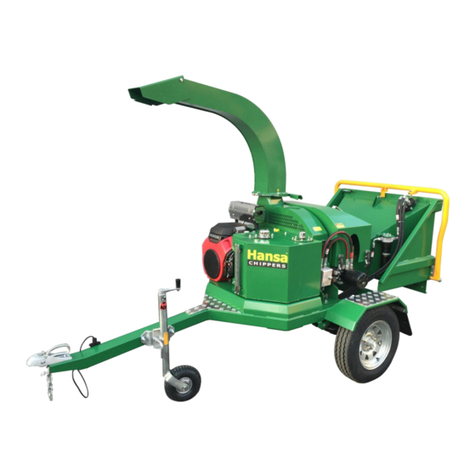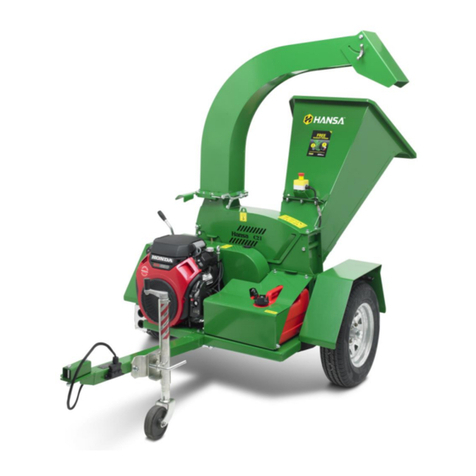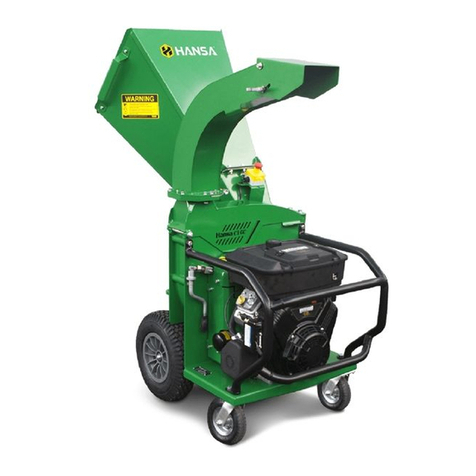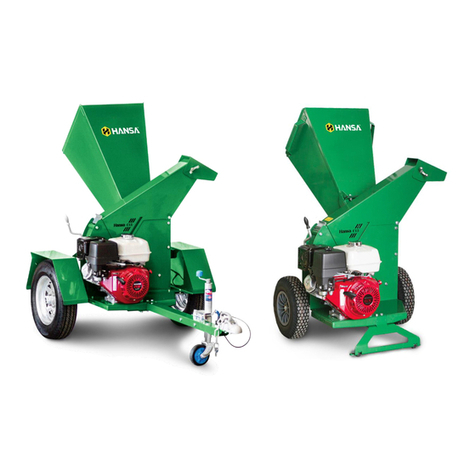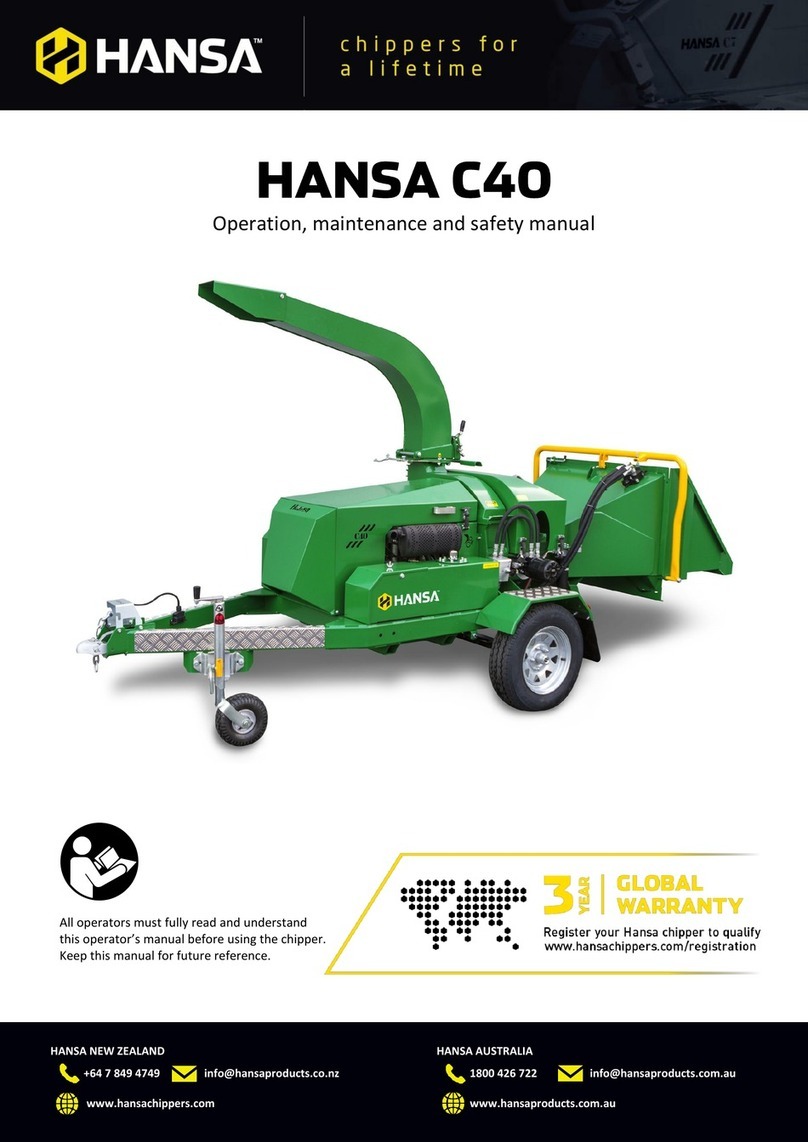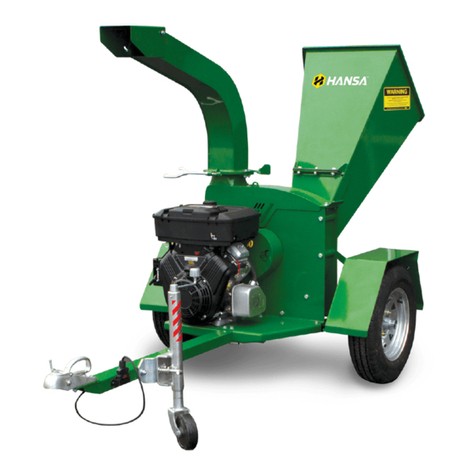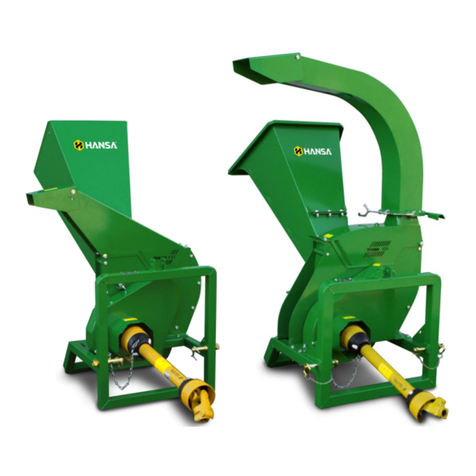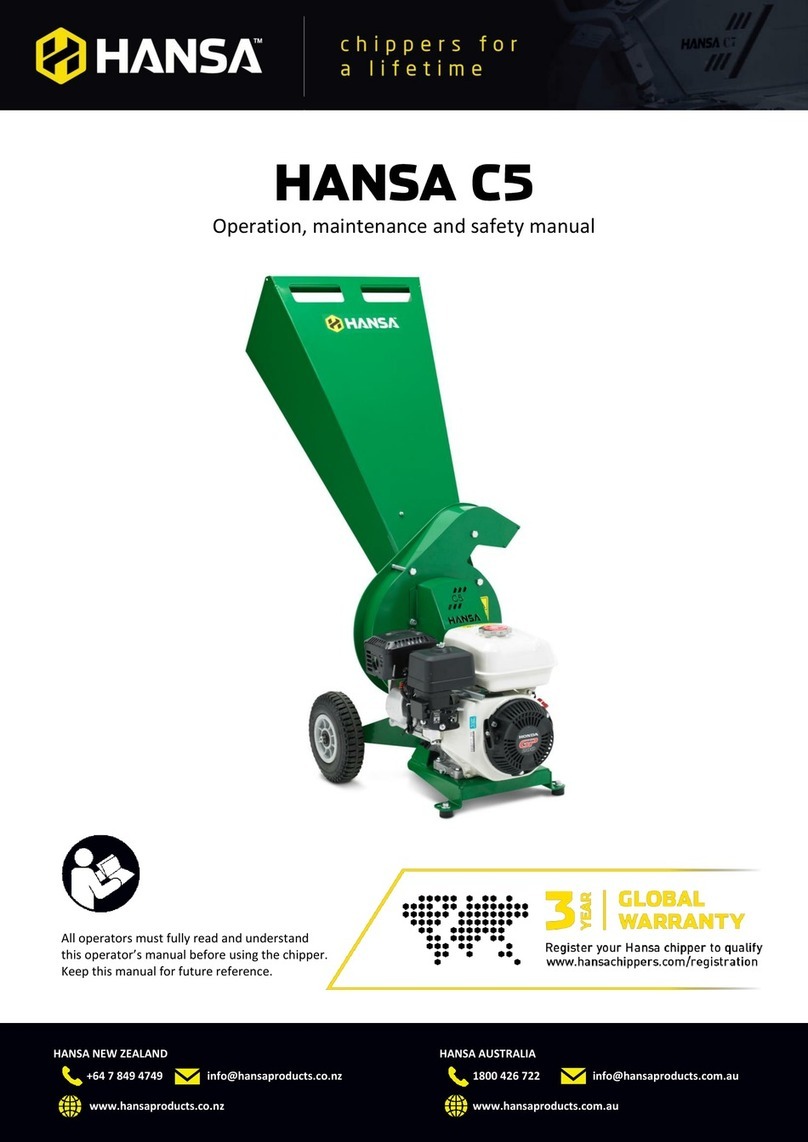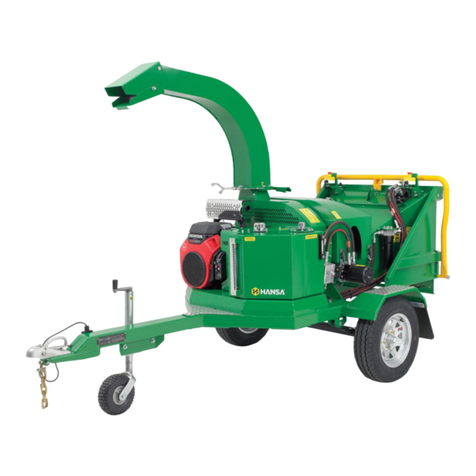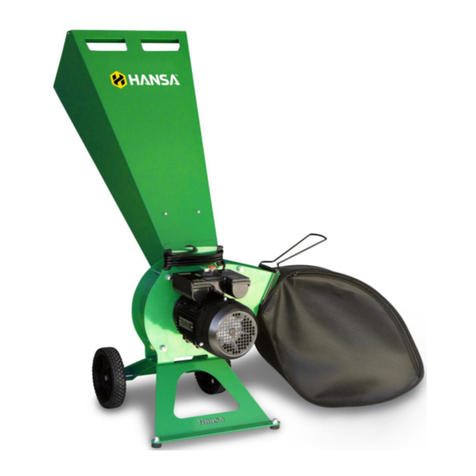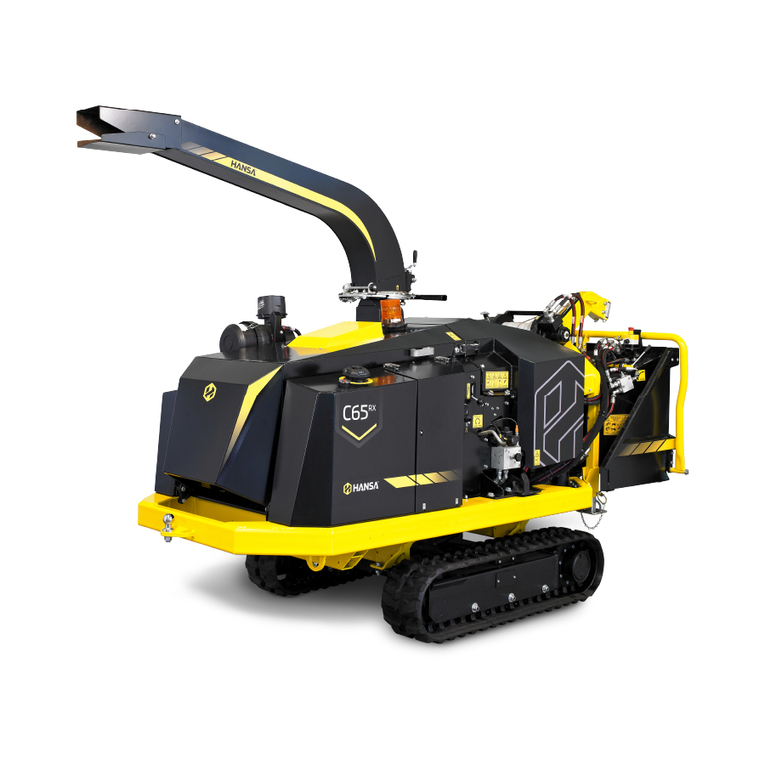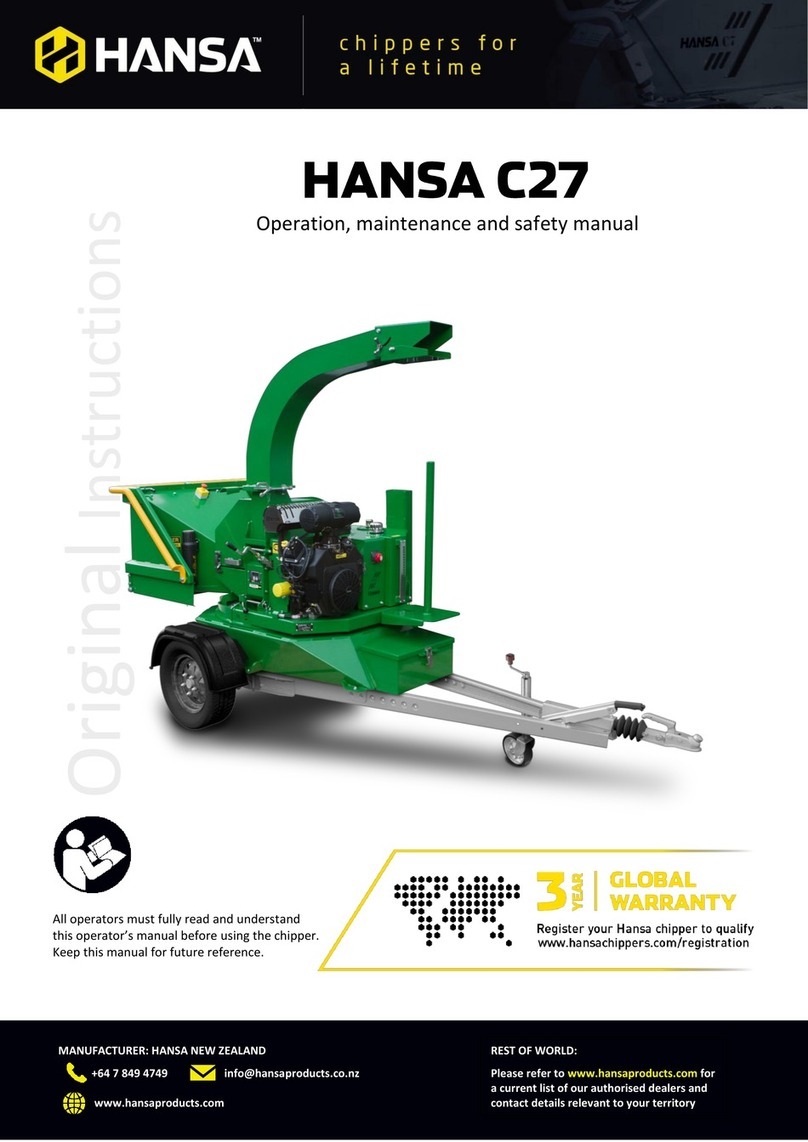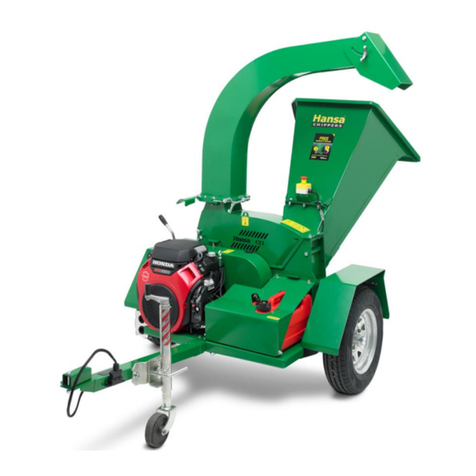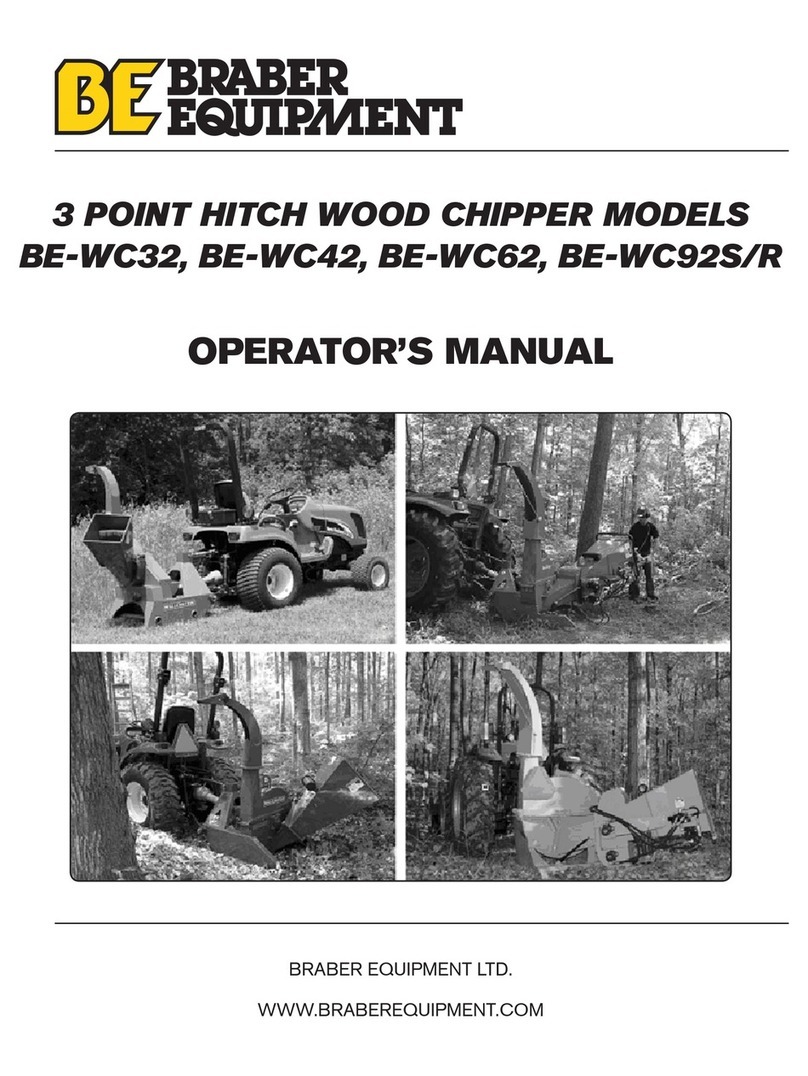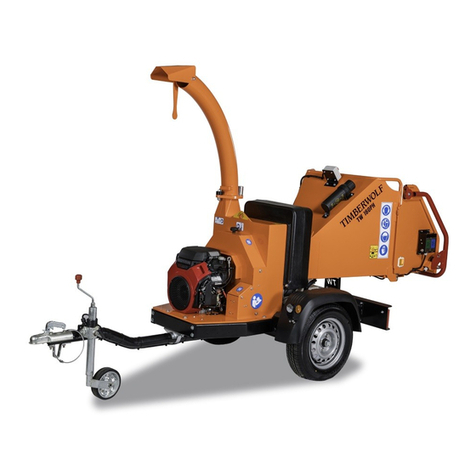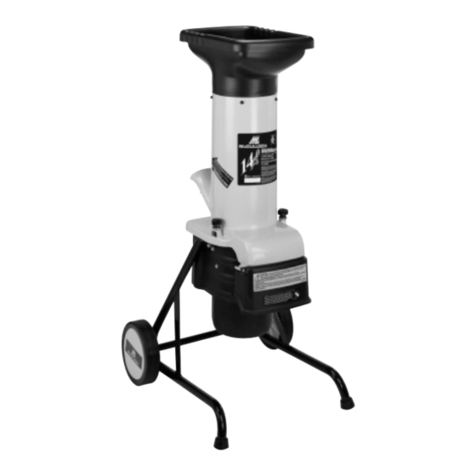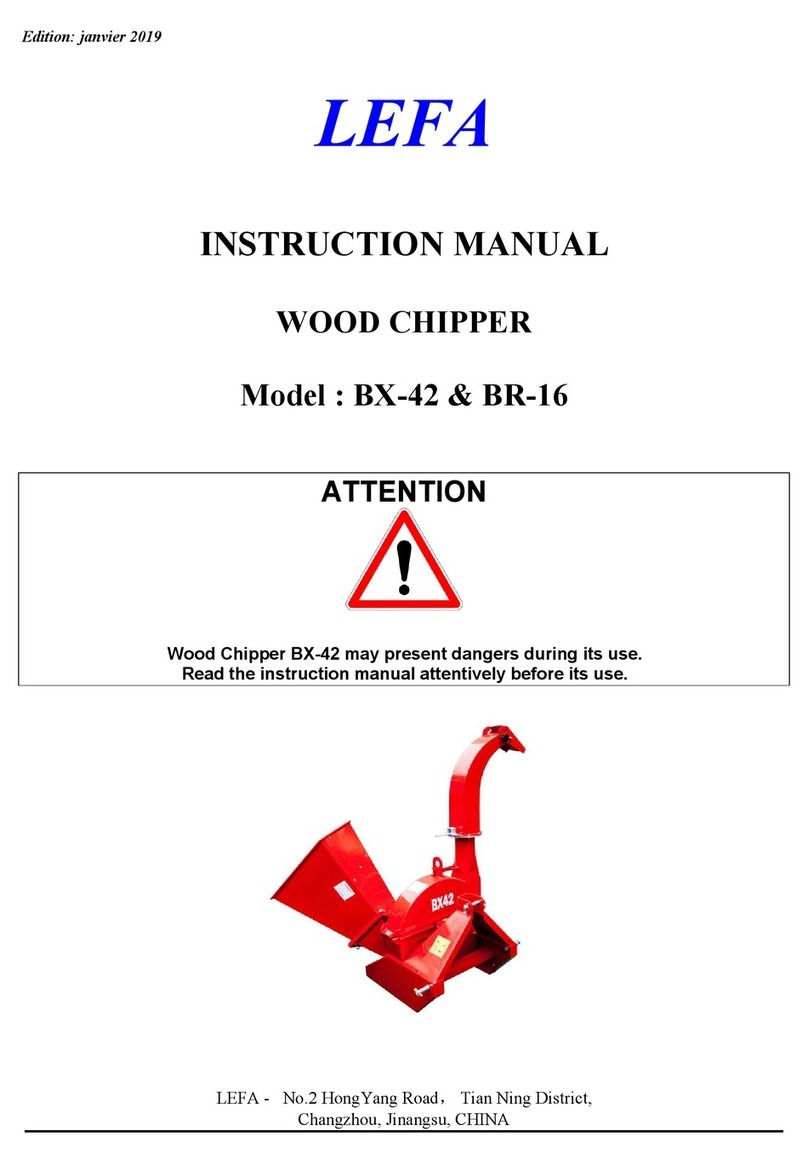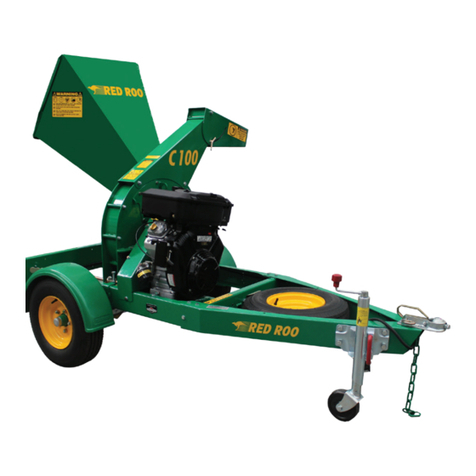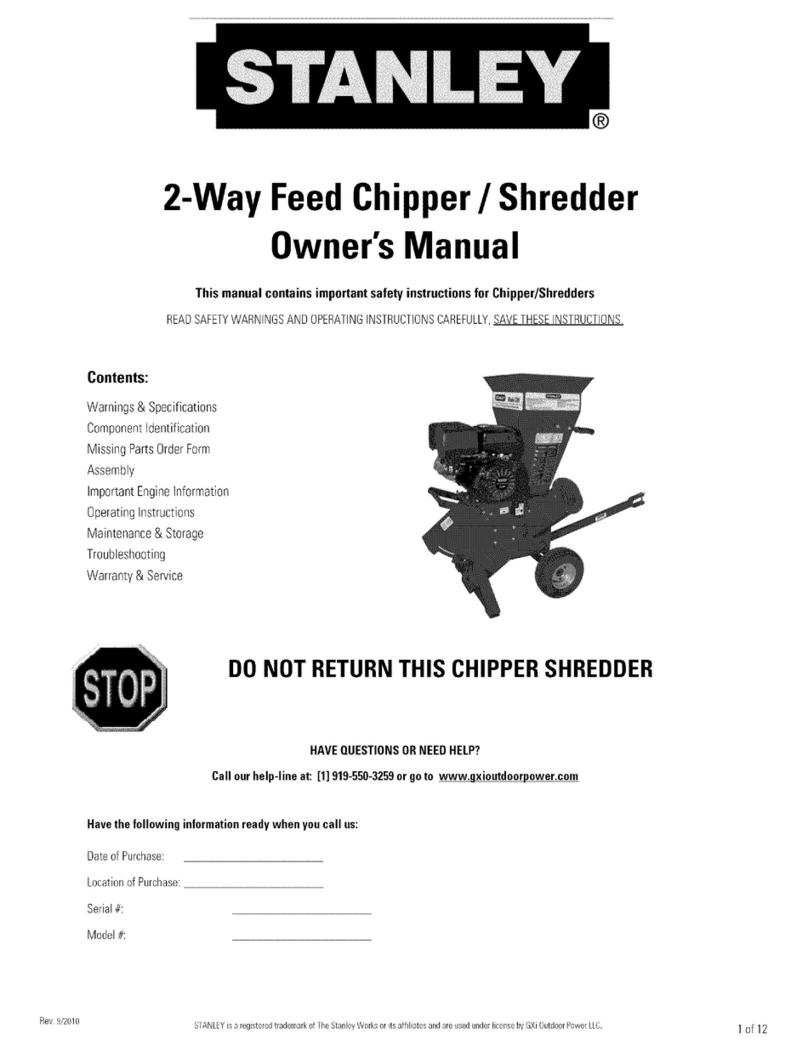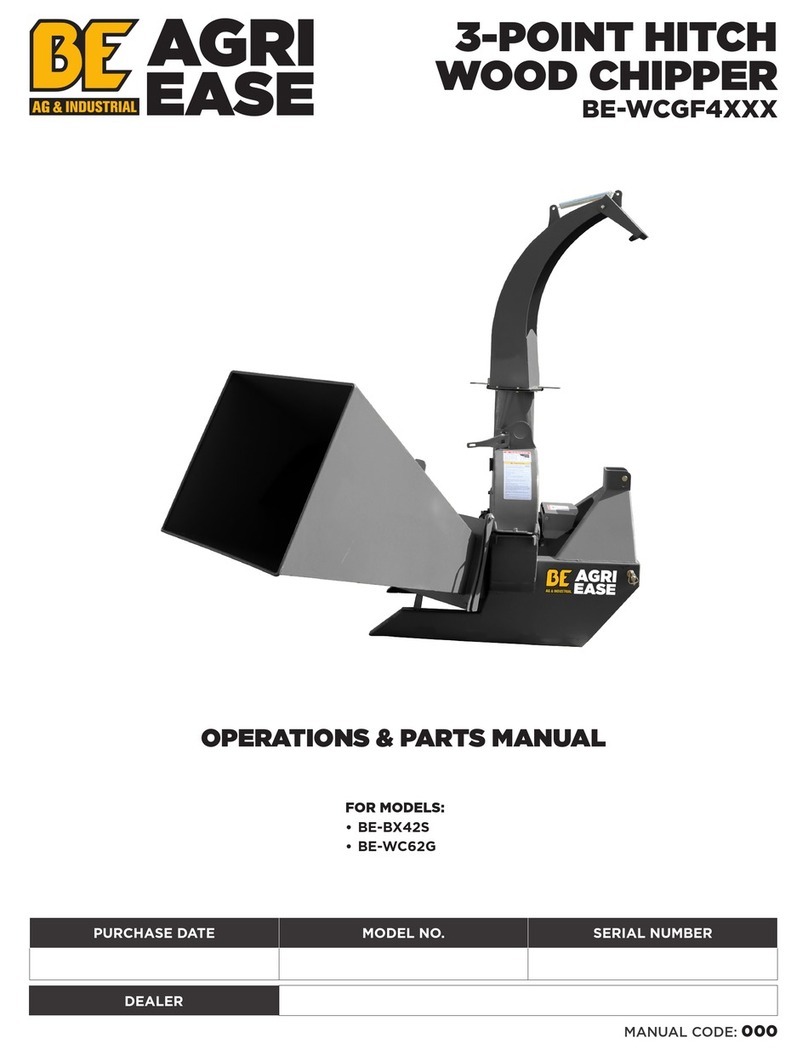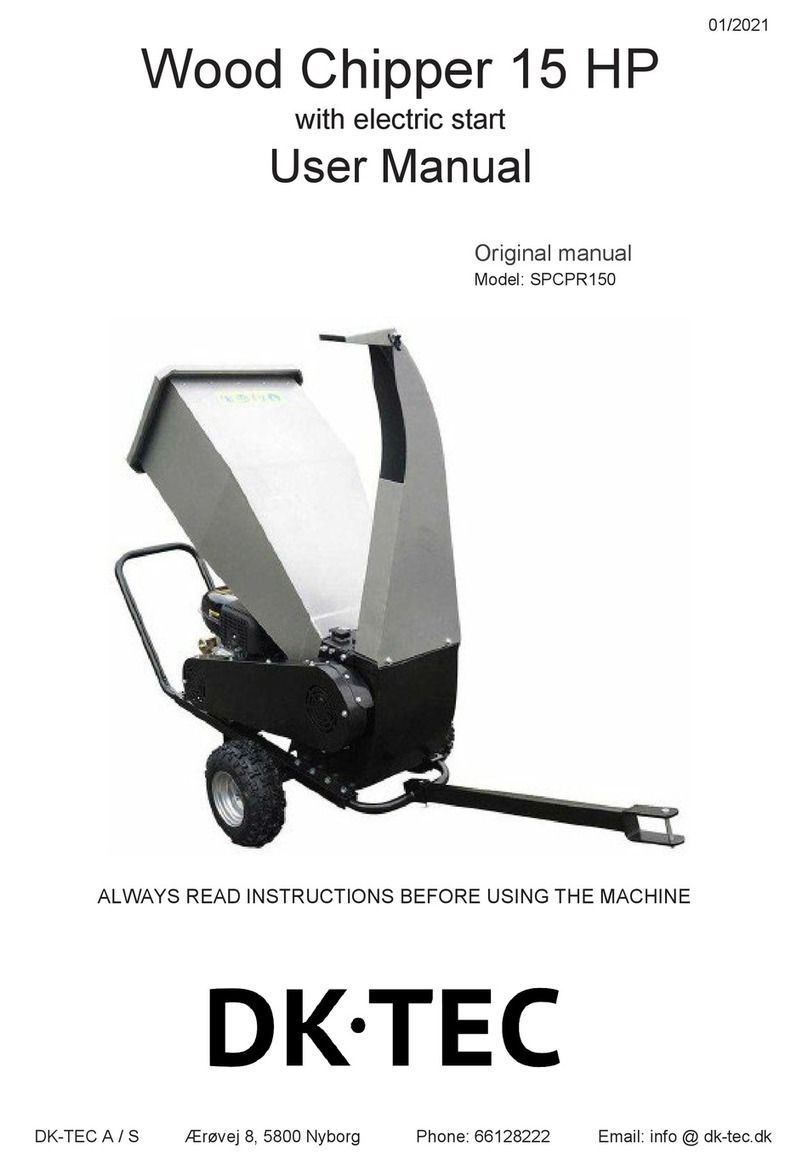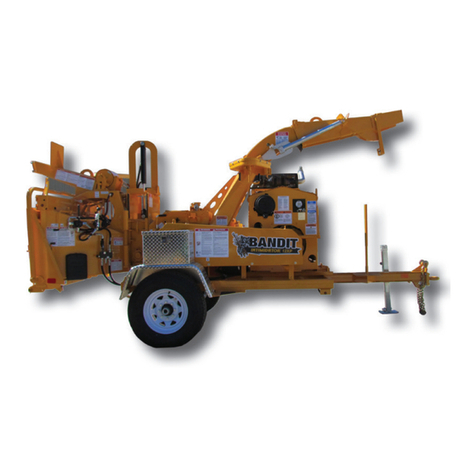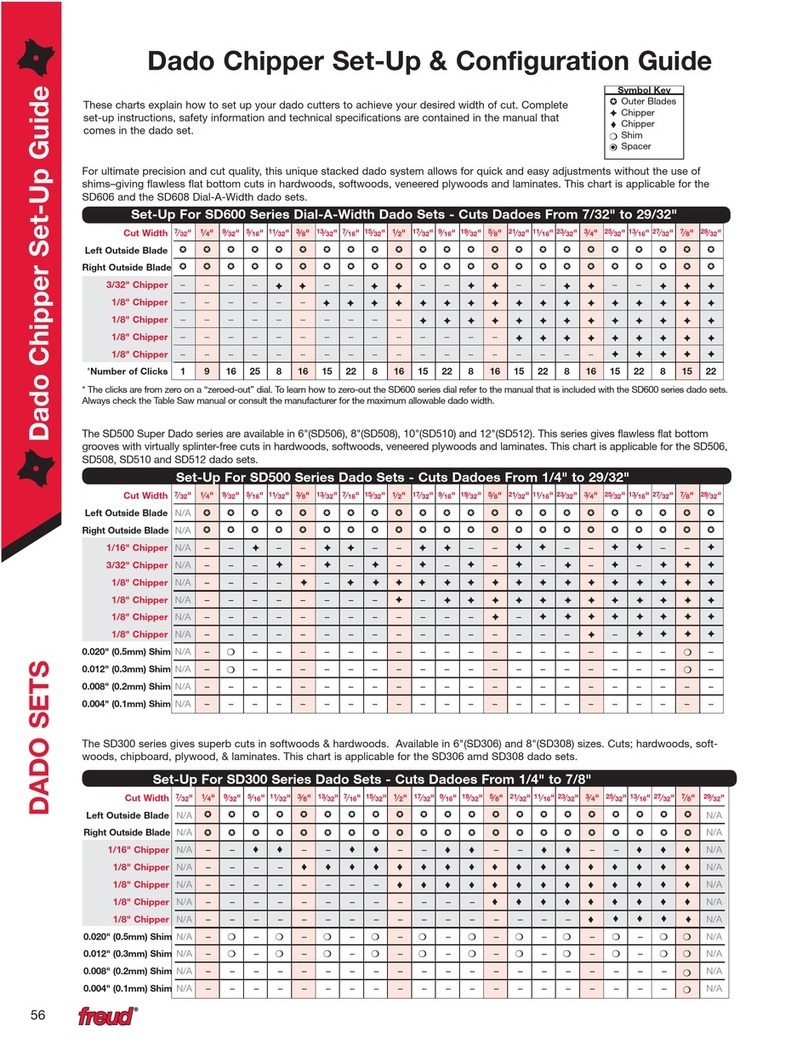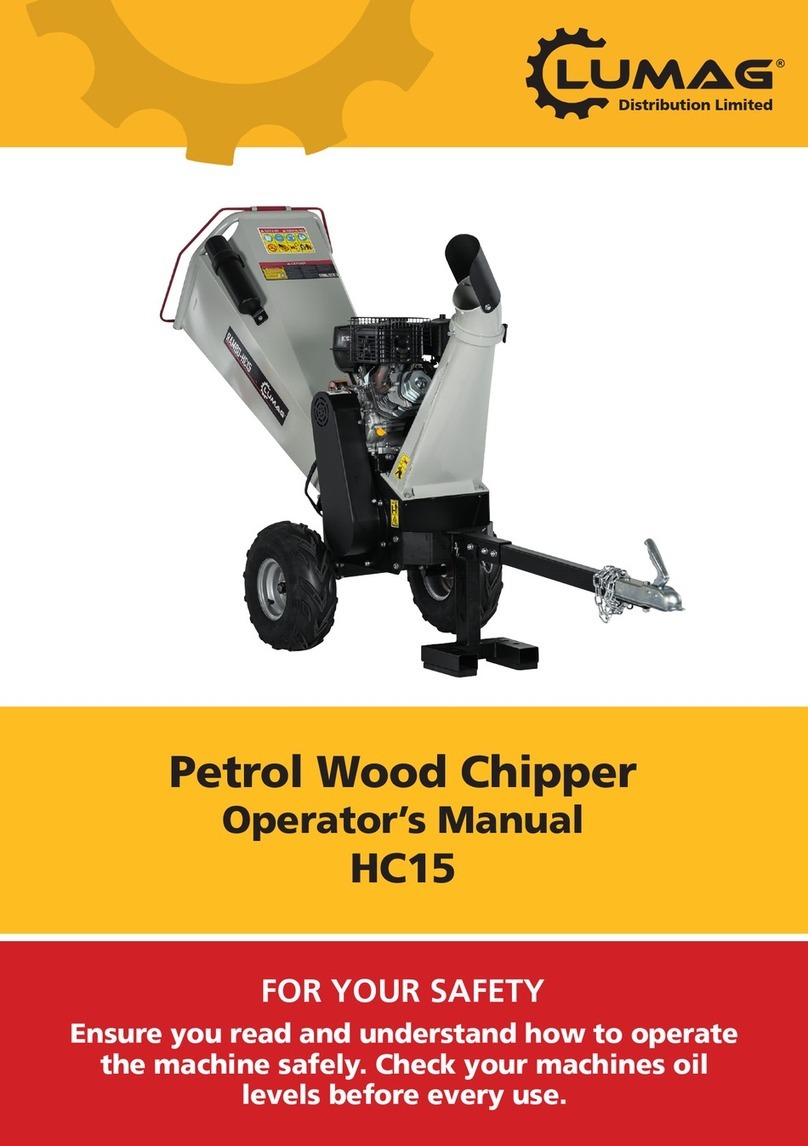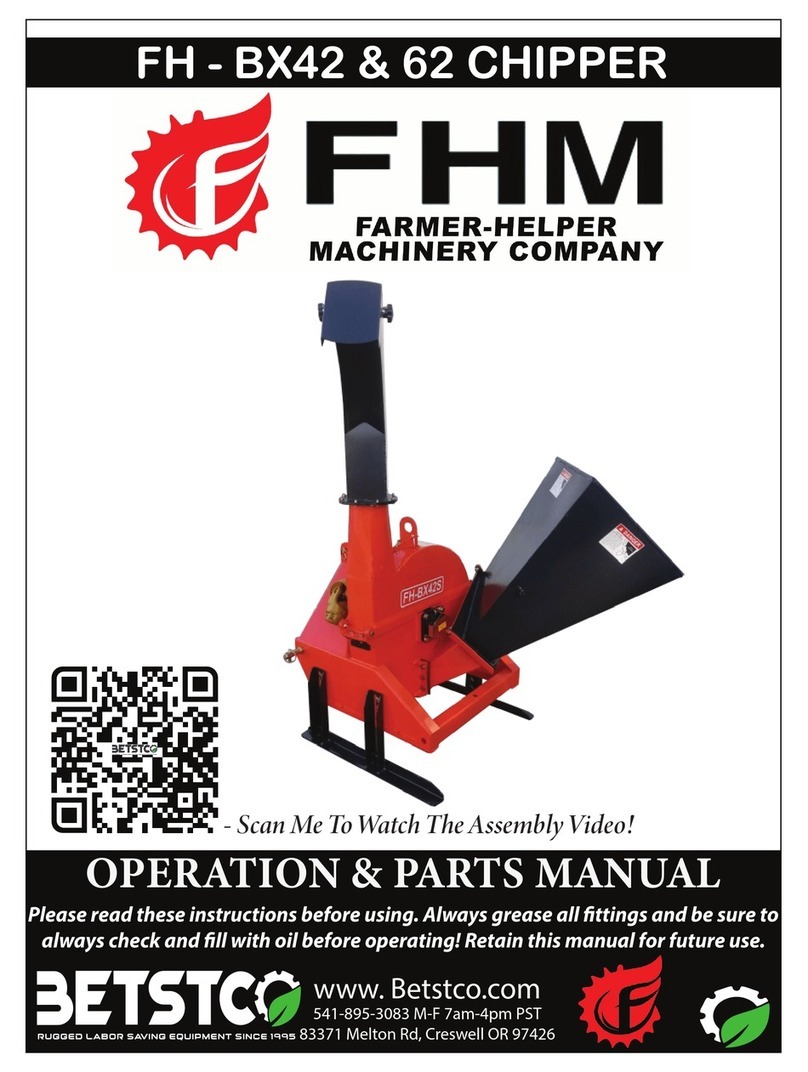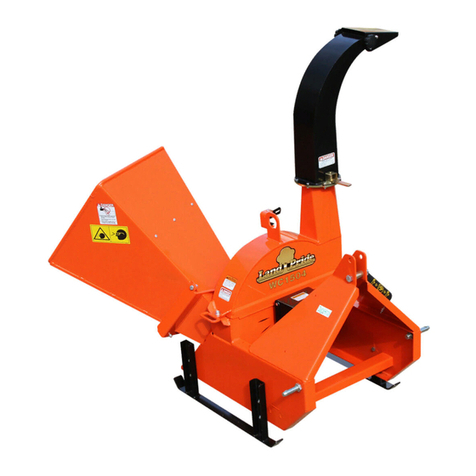Hansa C7 User guide

MANUFACTURER: HANSA NEW ZEALAND
+64 7 849 4749 info@hansaproducts.co.nz
www.hansaproducts.com
REST OF WORLD:
Please refer to www.hansaproducts.com for
a current list of our authorised dealers and
contact details relevant to your territory
Operation, maintenance and safety manual
All operators must fully read and understand
this operator’s manual before using the chipper.
Keep this manual for future reference.
Original Instructions

Hansa C7eu O&M Manual - OM-019 Revision A 03/09/2018
© Hansa Chippers 2018
TABLE OF CONTENTS
WHAT CAN MY HANSA CHIPPER PROCESS?..................................................................................................................................1
INTENDED USES OF THE CHIPPER ...............................................................................................................................................................1
RECEIVING YOUR HANSA CHIPPER ...............................................................................................................................................1
CHIPPER COMPONENTS........................................................................................................................................................................... 1
ASSEMBLY............................................................................................................................................................................................3
SAFETY .........................................................................................................................................................................................6
OPERATOR COMPETENCY.........................................................................................................................................................................6
IDENTIFYING HAZARDS AND RISKS ..............................................................................................................................................................6
OPERATION..................................................................................................................................................................................7
SAFE SETUP PROCEDURE..........................................................................................................................................................................7
SAFE OPERATING PROCEDURE...................................................................................................................................................................8
STARTING PROCEDURE ............................................................................................................................................................................9
SHUTDOWN PROCEDURE .......................................................................................................................................................................11
PROCESSING FIBROUS MATERIAL .............................................................................................................................................................11
PETROL.............................................................................................................................................................................................. 12
STORAGE.................................................................................................................................................................................... 12
TRANSPORTATION ..................................................................................................................................................................... 12
TROUBLESHOOTING................................................................................................................................................................... 13
WHAT TO DO IF:..................................................................................................................................................................................13
MAINTENANCE........................................................................................................................................................................... 14
KNIFE RE-SHARPENING AND KNIFE REPLACEMENT .......................................................................................................................................14
ENGINE SERVICING ...............................................................................................................................................................................17
ENGINE OIL......................................................................................................................................................................................... 17
BELT TENSION .....................................................................................................................................................................................17
BELT REPLACEMENT..............................................................................................................................................................................18
TYRE PRESSURE ...................................................................................................................................................................................20
BOLT TORQUE .....................................................................................................................................................................................20
SPECIFICATIONS ......................................................................................................................................................................... 20
HANSA GLOBAL INDUSTRIAL LIMITED WARRANTY..................................................................................................................... 21
DECALS....................................................................................................................................................................................... 23
SOUND OUTPUT INFORMATION ................................................................................................................................................ 24
EC DECLARATION OF CONFORMITY............................................................................................................................................ 25

Hansa C7eu O&M Manual - OM-019 revision B 03/09/2018
© Hansa Chippers 2018
1
What can my Hansa chipper process?
Intended uses of the chipper
The Hansa C7 chipper is built to process organic material including wooden branches not exceeding 70 mm in diameter. It is
designed for intermittent use by the suburban gardener. Do NOT use the chipper for any other purpose.
Organic wastes include:
Prunings, stalks, roots, vegetable matter, hay, grass, bark
Dry manure
Branches
Palm fronds
Dead and hard timbers (Note: these will dull the knives faster)
Paper or cardboard
Do NOT process:
Flax, root balls
Soil, bones, sand, grit, stones, metal
If you have any questions, contact your authorised dealer.
Do NOT exceed 70 mm branch diameter
Receiving your Hansa chipper
You may receive your chipper assembled from your dealer or it may be packaged in two boxes. Assembly takes approximately 30
minutes, two people working together will make the assembly easier.
Chipper components

Hansa C7eu O&M Manual - OM-019 revision B 03/09/2018
© Hansa Chippers 2018
2
Tools required for assembly (not supplied):
•A knife to cut open the box
•10 mm spanner –to fit the emergency stop bracket
•Two 13 mm spanners - to tighten the inlet chute
•14 mm spanner - to tighten the swivel handle
•16 mm spanner - to unscrew and tighten the axles
•6 mm Allen key - to tighten the wheels and the screws on the outlet chute
•4 mm Allen key –to fit the emergency stop bracket
Box 1 contains:
✓The chipper body
✓Two wheels
✓A cardboard block for support of the chipper body for wheel attachment
Box 2 contains:
✓The inlet chute
✓A fastener pack containing parts required for assembly
✓The outlet chute; packed into a separate cardboard box
✓Documentation (Hansa operations manual, warranty card and Honda motor manual)
All the C7 parts in two separate boxes
CAUTION: The chipper body weighs 70 kg; it is recommended to cut the box open rather than lifting the body out.
Contents in box 1
Box 1
Box 2
Contents in box 2
Inlet chute
Documentation
Outlet chute
Fastener pack
Wheels and cardboard block
Chipper body

Hansa C7eu O&M Manual - OM-019 revision B 03/09/2018
© Hansa Chippers 2018
3
Assembly
Assemble the chipper body
Place the cardboard block underneath the chipper body - this
makes it easier to attach the wheels.
Item no.
Fastener pack contents (in box 2)
1
One big spring washer for swivel handle
2
Two small spring washers for wheels
3
One swivel handle
4
Two bolts, spring washers, heavy washers, and nuts used to fix
the inlet chute to the chipper body
5
Two washers to fix wheels onto the axle
6
Four cap screws to attach the wheels and outlet chute to the
chipper body
7
Two nyloc nuts to fix screws on outlet chute
8
Two bolts, spring washers, and heavy washers, used to fix the
outlet chute to the chipper body
1

Hansa C7eu O&M Manual - OM-019 revision B 03/09/2018
© Hansa Chippers 2018
4
Untighten the screws of the axles, move the axles out and re-
tighten the bolts.
Slide the wheels onto the axles. Ensure valve is facing outwards.
Using a 6 mm Allen key, fasten the wheels to the chipper body.
Use the small spring washers (item no. 2), cap screws (item no. 6),
and big washers (item no. 5) to do so. Ensure the big washer is
touching the wheel followed by the smaller spring washers, then
the bolt head.
Fit the outlet chute
Slide the outlet chute over the black
cutting rotor onto the body; the open side
of the chute is facing the engagement
handle. Fix the outlet chute to the
chipper body by tightening the cap screws
(item no. 6) and nyloc nuts (item no. 7)
using a 6 mm Allen key and 13 mm
spanner.
2
3
4
5

Hansa C7eu O&M Manual - OM-019 revision B 03/09/2018
© Hansa Chippers 2018
5
Fix the other side of the outlet to the
chipper body by inserting two heavy
washers, two spring washers, and two 16
mm m8 bolts (item no. 8) into the
threaded holes on the chipper body.
Ensure the spring washer sits between the
bolt head and heavy washer. Use a 13 mm
spanner to ensure these are fully
tightened.
Fit the inlet chute
Fix the inlet chute - check that it slides in
on the top, and at the bottom. If the holes
don’t fit to tighten the screws, the best
option is to take the chute out and re-
insert it.
Line up the holes and insert the bolts,
washers and nuts (item no. 4), ensuring
the big washer is touching the bolt head
(top) and the spring washer is touching
the nut (bottom).
Attach the swivel handle
Attach the swivel handle (item no. 3) to
the engagement handle using a 14mm
spanner. Ensure the spring washer (item
no. 1) is placed on the thread of the
engagement handle before tightening it.
6
7
8
9

Hansa C7eu O&M Manual - OM-019 revision B 03/09/2018
© Hansa Chippers 2018
6
Attach the emergency stop bracket to the inlet
Remove the fasteners that come attached
with the bracket. Fasten the bracket to
the inlet chute using the supplied
fasteners, ensuring the bolt head is on the
inside of the inlet chute, and the light
washer and nyloc nut are on the outside
of the inlet chute. A 10 mm spanner and
4mm Allen key are required for this.
Safety
Preventing accidents is the responsibility of every equipment operator. The operator is responsible for any accidents or hazards
occurring to people or their property. Ensure every operator is familiar with the safe operation procedures and controls of the
machine, how to identify hazards, and the steps required to avoid injury while handling and operating the chipper. Relevant
information is contained in this manual.
Do NOT modify the design of the chipper.
Operator competency
Ensure that every person operating the chipper understands and follows the safe operating and maintenance procedures
as detailed in this manual.
Do NOT allow persons below the age of 16 to operate the chipper. Additionally, local regulations may restrict the age of
the operator.
Do NOT allow persons with reduced physical, sensory or mental capabilities, or lack of experience and knowledge to
operate the machine.
Identifying hazards and risks
Identify hazards and risks, and take preventative steps to avoid accidents and minimise risk. Possible hazards include, but are not
limited to, moving parts, thrown objects, weight of chipper and components, and the operating environment.
Below is a list of hazards and actions required to prevent injury.
Hazard
Risk
Corrective action
Dust
Injury or irritation of the
eyes
Respiratory irritation
Wear safety glasses
Process freshly cut materials and/or wear a dust mask
Exhaust Fumes
Respiratory irritation
Place the chipper in a manner that the operator is not
exposed to direct exhaust fumes
Hot Exhaust
Heat burns
Keep bare hands and other body parts a safe distance away
from hot exhaust
Fire
Heat burns
Clear any build-up of chipping debris around the engine and
exhaust regularly
Belt Drive
Skin pinching and/or
abrasions
Ensure that the belt guard is in place, and keep away from
the belt and its guarding
Cutting rotor and knives
Pinching, crushing, cutting,
severing
Keep your face and body out of the inlet chute
Do NOT extend hands/arms past the rubber flap
Use a stick to push materials into the inlet chute
Do NOT push the stick beyond the rubber flap
10

Hansa C7eu O&M Manual - OM-019 revision B 03/09/2018
© Hansa Chippers 2018
7
Sound
Damage to hearing
Always wear hearing protection when operating the
machinery
Discharge material
Eye injury, minor cuts
Always wear safety glasses when operating the machinery
Do NOT put any body part in front of the outlet
chute
Do NOT put the machinery in a place where the
outlet chute is directed on a hard surface
Feeding material
Cuts and scrapes
Wear safety gloves
Wear tight fitting long sleeves and pants to cover bare skin
when operating the machinery
Weight of the chipper
Straining, crushing
Place the machinery on level ground
Petrol, oil, grease
Poisoning, skin irritation,
harmful vapours
Take care when handling petrol, oil and grease
Wash skin if contaminated with petrol, oil or grease
Do NOT refuel the chipper in enclosed areas
Operation
The chipper is self-feeding and has a large inlet opening. It can process:
•Prunings, stalks, vines, leaves, roots and vegetable matter, paper and cardboard
•Freshly cut material is better to process than dry material
•Maximum capacity is 70 mm diameter branches
It is helpful (but not required) to keep a wooden stick handy, approx. 60 mm diameter x 600 mm long for:
•Pushing in short, brushy and very leafy materials
•Keeping the inlet chute clear
Safe setup procedure
Before you start:
Ensure the chipper is positioned in an open area and on firm level ground
Ensure that the outlet chute is discharged onto soft ground (e.g. grass)
Do NOT allow the outlet chute to discharge chip onto hard surfaces (such as a paved or gravel surface)
Ejected material can rebound and cause injury
Keep children, pets and spectators clear of the work area at all times
Do NOT operate the chipper where there is a hazard to onlookers
Do NOT allow any person under the age of 18 to operate the chipper
Check:
That all screws, nuts, bolts, and other fasteners are properly secured
That all chipper components are in place and in good condition
If any parts are worn or damaged, contact Hansa for replacements
That fuel and engine oil levels are above the minimum levels
That the fuel cap is secured and there is no fuel leaking from the tank
That the inlet chute and housing are clear of any leftover material
That all labels are in good condition and easily legible
Replace damaged or unreadable labels
View photos of labels in the ‘Decals’ section
Refuelling:
Take extra care in handling fuels
They are flammable and vapors are explosive
Use only an approved fuel container
Always replace and securely tighten fuel cap after refuelling
Allow engine to cool down before refuelling
If you need to drain the fuel, ensure this is done outdoors

Hansa C7eu O&M Manual - OM-019 revision B 03/09/2018
© Hansa Chippers 2018
8
Do NOT smoke when using or refuelling the chipper
Never remove fuel cap or add fuel with the engine running
Never refuel the chipper indoors
Never store the chipper or fuel container inside where there is an open flame, such as a water heater
If fuel is spilled, do not attempt to start the engine. Wipe up the spilled fuel, and move the chipper away from
the area of spillage before starting
Safe operating procedure
Wear safety equipment: Safety glasses and hearing protection must be
worn at all times
Wear work gloves: Wearing work gloves is optional but highly
recommended - ensure that the gloves fit tightly
Tie long hair up
Long hair could be pulled into the chipper
Wear clothes that sit tightly
Avoid scarves and any items that can get caught in the chipper
Keep your face and body away from the inlet chute
Stand clear of the discharge zone, even when no material is being fed into the machine
Place the chipper on even ground and direct the outlet chute onto soft ground
Ensure the exhaust is pointing away from the working area and downwind from the operator and onlookers
Keep proper balance and footing at all times and stand at the same level as the chipper
Do NOT overreach
Do NOT run near the chipper
Feed only freshly cut material into the chipper
Do NOT feed in materials covered in gravel, stones and dirt as this can rebound, injure the operator and damage
the machinery
Prune to a size that suits the chipper’s capabilities
Pre-cut side branches
Branches will ‘self-feed’ more efficiently
Keep the engine clean of debris and other accumulations
This prevents damage to the engine or possible fire
Feed limbs and branches through butt end first, leaving the foliage on
This helps guide the limb down the inlet chute
It reduces spinning and the occurrence of ejection of small pieces back up the inlet chute
Hold larger branches back and feed the chipper with care until you are familiar with its capacity
The engine will slow down or stall if the branch is too large
Feed longer pieces together with short stubby pieces
Feed soft materials intermittently with branches
The wood chips tend to clean out any soft residue left in the chipper
The chipper can clog up with soft, wet or fibrous materials
Keep the outlet free of blockage
If a blockage occurs, turn the engine off, disconnect the spark plug wire, and wait for rotor to stop spinning. Open
the outlet chute and remove material until the outlet chute is clear
As the discharge material piles up
Move the chipper to direct the outlet chute away from the pile, or move the processed material
to avoid blocking
Turn off the engine whenever you leave the work area
Run the chipper in an enclosed area
Exhaust fumes contain carbon monoxide which is poisonous, colourless, odourless, and tasteless
Operate the chipper wearing loose clothing and untied long hair
Stand at a higher level than the base of the chipper when feeding material into it
DO:
DO NOT:

Hansa C7eu O&M Manual - OM-019 revision B 03/09/2018
© Hansa Chippers 2018
9
Process old materials such as dried wooden branches
They get very hard and springy when dried out
They are more awkward to handle
The knives dull much quicker
Feed short, stubby pieces of wood into the chipper
They bounce and spin in the inlet chute
Feed short stubby pieces together with longer pieces
Feed branches that are too large
The chipper can easily stall
Put soil, sand, grit, stones, glass, pieces of metal or other foreign objects into the chipper
This will damage the sharp edge of the cutting knives and can rebound and injure the operator
Put root balls and dead wood into the chipper
This dulls the knives quickly
Overload the chipper
If the cutting rotor is slowing down, feed the material in slower
Allow processed material to build up in the discharge area as this can:
Prevent proper discharge
Result in kickback of material through the feed opening
Transport the chipper while the engine is running
Tamper with the engine governor settings on the chipper
The governor controls the maximum safe operating speed and protects the engine and all moving parts from
damage caused by overspeed
Operate the chipper with blunt knives
This causes excessive vibration which may result in damage to the chipper
Move or tilt the machine while it is running
Touch any guards or stick hands between guards
Put hands or any other part of the body or clothing:
Inside the feed chute past the rubber flap
Inside or near the opening of the discharge chute
Near any moving part
Remove any guards on the chipper unless the engine is turned off and the cutting rotor has come to a complete standstill
Leave the chipper on while it is unattended
Starting procedure
Before proceeding, ensure the ‘safe setup procedure’ has been followed on page 7 of this manual.
Ensure the emergency stop is
disengaged. Turn the choke lever, fuel
lever, and engine switch to the “on”
position.
1
1
Choke lever
(“on” position)
Fuel lever
(“on” position)

Hansa C7eu O&M Manual - OM-019 revision B 03/09/2018
© Hansa Chippers 2018
10
Turn throttle to “max” position and
disengage the belt drive by winding the
engagement handle anti clock-wise
until it comes to a stop.
Pull the pull cord in one smooth motion
to start the engine.
Once the engine is started and has
warmed up (approx. 30 seconds), turn
the choke lever to the “off” position (as
shown in the picture).
To engage the belt drive, slowly rotate
the engagement handle clockwise until
it comes to a stop.
This must be done slowly to allow the
cutting rotor to pick up speed;
otherwise the engine may stall.
2
3
4
5
Throttle
lever (“max”
position)
Pull cord

Hansa C7eu O&M Manual - OM-019 revision B 03/09/2018
© Hansa Chippers 2018
11
WARNING! Do NOT disengage the belt drive with the chipper running at full revs, as this will cause friction and vibration
on the belt drive.
Processing fibrous material
The C7 can process palm fronds, flax, cabbage tree leaves and other similar fibrous material. The machines cutting disk is
cantilevered (supported on the engine side with two bearings), therefore there is no risk of anything fibrous wrapping around the
shaft and working its way into the bearings. The resulting output is not as consistent as that of branch material due to the fibrous
nature. When processing fibrous material, take note of the following points:
Blades must be sharp to process fibrous material
Fibrous material is best introduced to the machine as a bundle
Fibrous material should be introduced slowly into the machine. Tease the material in and out while feeding it into the
cutting mechanism, ensuring it is not drawn through the machine without being cut properly
Do NOT extend hands past the rubber flap while doing so
Fibrous material is processed more effectively when it is green rather than when dried
Shutdown procedure
Turn the throttle lever to the “min”
position and wait for the rotor to slow
down.
Disengage the belt drive by rotating
the engagement handle anti clock-wise
until it comes to a stop.
Turn the engine switch and fuel lever
to the “off” position.
1
2
3
Throttle
lever (“min”
position)
Fuel lever
(“off”
position)

Hansa C7eu O&M Manual - OM-019 revision B 03/09/2018
© Hansa Chippers 2018
12
Petrol
The chipper requires 91 unleaded or E10 petrol to run; check the petrol level before
starting.
Storage
Always allow the chipper to cool before storing
Store the chipper out of the reach of children
Store the chipper where fuel vapor will not reach an open flame or spark
Switch the fuel lever to the off position
For extended storage periods, run the engine dry of fuel
Store the chipper out of the rain
Water can rust the steel body of the chipper
Transportation
The C7 is designed to be moved by one person using both handles at the top of
the inlet chute to lean the chipper backwards and transfer its weight onto the
wheels. The chipper can then be wheeled to and from the work location.
Take care when moving the C7 up and down stairs or kerbs
oThe wheels can be damaged by the shock loading caused by
uncontrolled ascent/descent
oThe chipper is heavy and the operator can lose control of the
machine
Do NOT move the chipper while it is running
For long distance transport by means of a vehicle, the C7 may be transported
as a single unit or with the inlet and/or outlet chute removed. If it is being
transported in parts, then ensure the body of the chipper is upright and stable.
If being transported as a single unit, then ensure that the C7 is secured by a
strap via the tie-down points on the front and back of the rotor enclosure.
Do NOT attempt to lift the chipper with less than 3 able-bodied people
The chipper weighs approximately 95 kg
Take care when handling chipper components
Chipper body has a mass of 70 kg
Inlet chute assembly has a mass of 20 kg
Outlet chute assembly has a mass of 6 kg
Ensure there is no debris or water trapped in the housing that may spill during transit.
Ensure the engine fuel valve is in the OFF position and that the engine is kept upright and stable
Handles
Tie down point

Hansa C7eu O&M Manual - OM-019 revision B 03/09/2018
© Hansa Chippers 2018
13
Troubleshooting
What to do if:
The chipper won’t start
•The engine oil level might be too low
The chipper is fitted with oil alert and will not start if the oil level is too low
Check the oil level and top up if required
•The chipper is placed on a slope
The chipper is fitted with oil alert and will not start if the oil is not level
Move the chipper to level ground
Belt drive engagement will not work
•The inlet chute or housing might be blocked
Turn engine off, disconnect the spark plug wire, ensure rotor has completely stopped, remove debris,
restart engine, then attempt to re-engage the belt drive
The chipper slows down and stalls
•The chipper is clogged up
Turn the engine off, disconnect the spark plug wire, ensure rotor has completely stopped, remove debris,
then close and lock the outlet chute
Discharge slows down
•The chipper is clogged up
Turn the engine off, disconnect the spark plug wire, ensure rotor has completely stopped, remove debris,
then close and lock the outlet chute
The chipper is slowing down
•The chipper can’t process the amount of material fed into it
Feed the material in slower
Reduce material volume
The chipper will not self-feed
The knives and/or anvil might be blunt
Inspect and sharpen or replace knives and/or anvil as required. Ensure correct clearances between
knives and anvil
The material is ejected in long strips
•The knives and/or anvil might be blunt
Inspect and sharpen or replace knives and/or anvil as required. Ensure correct clearances between
knives and anvil
The chipper is clogged
Turn the engine off, disconnect the spark plug wire, ensure rotor has completely stopped, remove
debris, then close and lock the outlet chute
The chipper starts making unusual noise, the cutting rotor strikes a foreign object or the chipper starts to vibrate
Turn the engine off, disconnect the spark plug wire, ensure rotor has completely stopped, then inspect
for damage
Replace or repair any damaged parts
Check for and tighten any loose parts
Do NOT attempt to repair the chipper unless you are competent to do so
WARNING! Do NOT open the housing unless the engine and cutting rotor have completely stopped.

Hansa C7eu O&M Manual - OM-019 revision B 03/09/2018
© Hansa Chippers 2018
14
Maintenance
Maintain the chipper with care and keep it clean at all times.
To service or inspect the equipment, or to change an accessory, you must:
✓Switch the engine off
✓Allow the chipper to cool before any inspections or adjustments
✓Wait until the cutting rotor and engine are at a complete standstill before opening the cutting
rotor housing
✓Disconnect the spark plug wire from the spark plug
✓Switch fuel lever to off position
Initially after 2 working hours:
✓Check for any loose nuts and bolts
✓Check belt tension (refer to belt tension section)
The belts will stretch when they are new
✓Grease the two rotor bearings, one on the inside and one on the outside of the housing
One or two pumps are sufficient
Be careful not to over grease
The bearings are already greased when the equipment is new
Use bearing grease or all-purpose grease
Every 20 working hours:
✓Check for any loose nuts and bolts
✓Check belt tension (refer to belt tension section)
✓Grease two bearings as above, be careful not to over grease
✓Check sharpness of knives
✓Check condition of guarding (belt guard and outlet chute)
A damaged guard must be replaced by an identical or equivalent guard immediately
It is recommended to contact Hansa for a replacement guard.
Knife re-sharpening and knife replacement
How do I know that the knives need re-sharpening?
Chipper loses its self-feeding action with blunt knives
Material has to be pushed in
Material comes out in long strips
Blunt knives will cause excessive vibration
Blunt knives result in damage to the chipper
How to re-sharpen the knives
If you don’t have a surface grinder or are unsure how to re-sharpen the knives, contact a professional saw doctor or Hansa to
arrange re-sharpening.
Tools and materials required for re-sharpening (approx. 40 mins)
•13 mm spanner
•6 mm hexagonal Allen key
•A stick magnet (optional)
•Surface grinder
•Coolant
WARNING! Do NOT operate your chipper with blunt knives.
WARNING! Be careful when working around the sharp knives. Be aware that even though the engine is switched off,
the cutting means can still move.
Disconnected spark plug

Hansa C7eu O&M Manual - OM-019 revision B 03/09/2018
© Hansa Chippers 2018
15
Remove the knives for sharpening
Open the rotor housing cover by removing the two outlet chute locking bolts with a 13 mm spanner, then lift the
rotor housing cover to access the cutting rotor. Rotate the cutting rotor to gain access to the knives, then engage
the belt drive to stop the cutting rotor from rotating.
Use a 13 mm spanner to remove the knives from the rotor. There are three
nuts you must remove to do so.
If the bolt head turns, hold it with a 6 mm hexagonal Allen key
Note:Do NOT try to loosen the bolt with the hexagonal Allen key
Be careful not to drop the nuts, bolts, washers or knives into the
chipper
A stick magnet can be used to retrieve them if this does occur
Measure the width of the knife and check that it will be at least 35 mm
after sharpening. If the knives will be shorter than 35 mm, then the knives
should be replaced. Please contact your nearest Hansa dealer.
Sharpen the knives
Sharpen the knives on a surface grinder. A cutting angle of 40 ° is critical
for the performance of the chipper. Make sure plenty of coolant is used
when grinding to avoid softening of the steel knives.
Reinstall the knives
Clean all mounting surfaces and remount the knives in the reverse procedure. Tighten the nuts using a torque
wrench to 22 Nm.
1
2
3
MIN 35 mm
4
5
40 °

Hansa C7eu O&M Manual - OM-019 revision B 03/09/2018
© Hansa Chippers 2018
16
Adjust the anvil at this stage as the
location of knife edge will change after
sharpening or replacement.
The anvil is reversible. Normally the
edge will last for over 200 operating
hours. When the edge is dull, it can be
reversed. When both edges are worn,
the anvil should be replaced (contact
Hansa for a replacement).
The clearance between the knife and
anvil should be approx. 1 mm on the
inside closest to the bearing and 3 mm
on the outside closest to the edge of
the rotor (refer to diagram for more
detail). Ensure you are using the outer
blade of the rotor for calibrating these
distances.
The gap between the knives and the
anvil is tapered out slightly to allow for
a small amount of movement in the
rotor as it bites into the wood.
The anvil position can be adjusted by
loosening the anvil mounting bolts.
Once adjusted correctly, tighten the
anvil mounting nuts using a torque
wrench to 22 Nm.
If there is not enough clearance, the
knife edge may touch the anvil
through deflection when cutting
heavy branches and damage the sharp
edge. Too much clearance will allow
small twigs and fibrous materials to be
dragged through without being cut.
Turn the cutting rotor by hand to
check that it turns freely.
Close and secure the outlet chute.
WARNING! Every time the knife clamping bolts are torqued up to 22 Nm and loosened off again, the life of the bolts is
reduced. The knife clamping bolts must be replaced at most after every six sharpens. Contact Hansa for replacement
bolts (m8x30 countersunk bolts of grade 12.9 or higher). Use only genuine Hansa bolts.
6
7
Top view: Outer knife and anvil set-up
Rotor
Knife
Anvil
Side view: Knife and anvil set-up
Outer
knife
Inner
knife
Bearing
Edge of
rotor
Anvil
Knife
1 mm
clearance
3 mm
clearance
Rotor

Hansa C7eu O&M Manual - OM-019 revision B 03/09/2018
© Hansa Chippers 2018
17
Engine servicing
For servicing of the engine, please refer to the Honda engine manual.
Engine oil
It is recommended you check the oil level every time you use your chipper. To check the oil level,
unscrew the oil filler cap/dipstick, clean the dipstick, then insert the dipstick without screwing it
into the thread. Fill as necessary, using the diagram as a reference. For optimal performance of
your chipper, the engine oil should be completely changed every 100 operating hours, or roughly
once every 12 months on average.
If the engine oil needs to be changed, follow these steps:
Run the engine for 1-2 minutes to warm up the oil.
Switch the engine off after the oil is warm. Place a
container underneath the engine. Remove oil filler
cap/dipstick and oil drain plug (using a 10 mm
spanner), then let the oil drain into the container
through the opening in the chassis.
Screw the oil outlet drain plug back in and fill the engine with 0.6 Litres of SAE 10W30 or SAE 10W40 through the
oil filler cap/dipstick hole (the oil should reach the thread near the hole opening).
Using the dipstick, check the oil to make sure it is at the right level (close to the upper limit, but not over). Screw
the oil filler cap/dipstick back into the hole. Dispose of the used engine oil in an environmentally sensitive way.
Belt tension
Correct belt tension is crucial for minimising belt wear and maximising machine efficiency. To check the belt tension, first ensure
the belt drive is disengaged by turning the engagement handle anticlockwise. Then, from the fully disengaged position, gently turn
the engagement handle clockwise until you feel it start to resist. From this position, turn the engagement handle clockwise. If the
tension is set correctly, the handle should turn one full revolution clockwise before coming to a stop. If there is a difference greater
than 1/6 of a revolution either clockwise or anticlockwise from one full revolution, then the belt tension should be corrected
following the ‘adjusting belt tension’ procedure.
Adjusting belt tension
Using two 24 mm spanners, unlock the two locking nuts from
above the adjustment block on the engagement handle by
turning the top nut anticlockwise and the bottom nut
clockwise. Then move both locking nuts upward along the
thread.
1
Oil filler
cap/dipstick
Oil drain plug
2
3
1
Adjustment
nuts
Adjustment
block

Hansa C7eu O&M Manual - OM-019 revision B 03/09/2018
© Hansa Chippers 2018
18
From the fully disengaged position, gently turn the
engagement handle clockwise until you feel it start to resist.
From this position, turn the engagement handle one full
revolution clockwise. This is the recommended tension for the
belt drive when in the fully engaged position.
Using two 24 mm spanners, screw the two M16 adjustment
nuts downwards until they touch the adjustment block. Then
turn the top nut clockwise and the bottom nut anti clockwise
simultaneously to lock the nuts in place.
Belt replacement
If the belts in your chipper look similar to any of the following images or are clearly broken, then they need to be replaced.
If a belt change is necessary, follow these steps:
Using a 6 mm Allen key, unbolt and remove the pulley
guard (3 x M8 cap screws).
Note: Engine not shown in this view.
2
3
1
Cracked underside of belt
Sidewall belt wear
Soft, swollen belt
Worn cover on back of belt
Split belt cover
Adjustment
nuts
Adjustment
block
Table of contents
Other Hansa Chipper manuals
